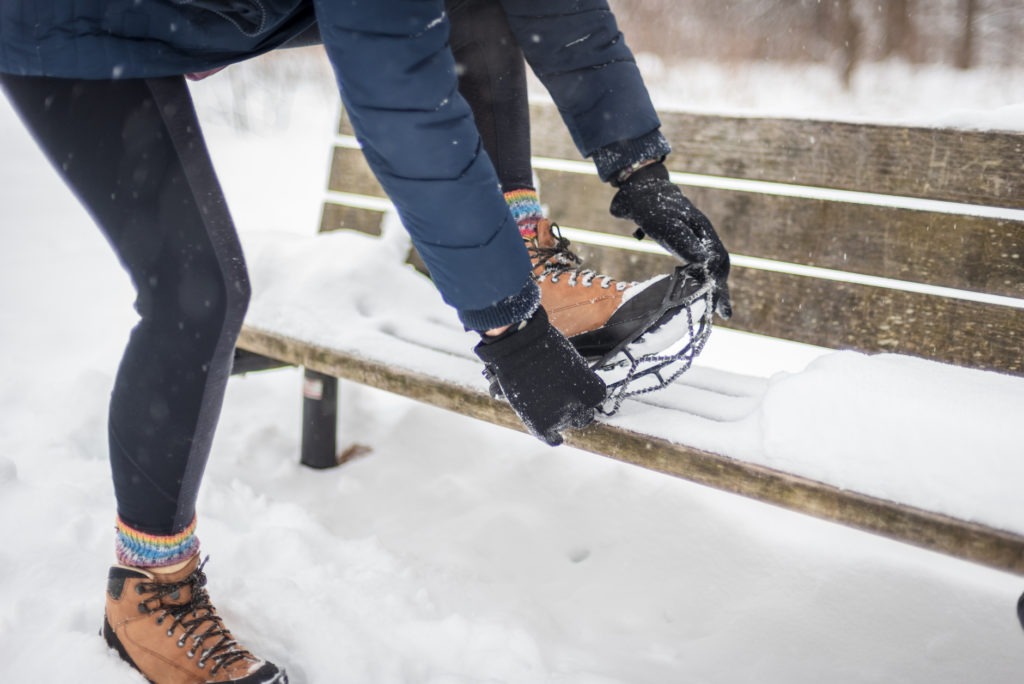Walking Safely On Winter Ice
Slipping and falling is no laughing matter. Stay safe this winter with these must-read tips!

From the golden age of cinema to America’s Funniest Home Videos to a dizzying array of Youtube videos, it seems we can’t get enough of watching other people slip and fall. While there’s no denying the allure of a good pratfall, the World Health Organization estimates that as many as half a million people die from falls each year. And that’s nothing to laugh at.
While far from the only slip and fall hazard, ice can make getting around difficult. Be safe this winter season with these helpful tips:
Walk Like a Penguin
Many people who live in cold climates rarely, if ever, slip and fall, because they’ve learned to adapt with a special walking technique. They walk like penguins. To walk like a penguin, just remember to always shift your center-of-gravity over your front facing foot instead of splitting it evenly between your feet, as illustrated below:

Treat Your Feet
Even if you know the right way to step, walking on ice will be much easier if you have the proper traction. Get some good winter boots with a large tread. For even better traction, you can pick up a pair of ice cleats, such as Yaktrax or Stabilicers, for less than $20. These easy-to-attach steel coils or spikes slip over your shoes to add gripping power on ice for better balance.

Learn to Fall
Believe it or not there’s a right way to fall. Martial artists fall all the time without getting hurt, because they practice falling the right way. Knowing this technique could mean the difference between bruising only your pride and making a trip to the emergency room.
The most important thing to remember is to protect your head. Broken bones heal, but a head injury can be deadly. If you think you are going to fall, tuck your chin against your chest to prevent your head from hitting the ice or pavement. You can also cradle you arms around your head for extra protection.
By tucking your chin, you’ve begun the process of arching your spine. As you fall, try to fold your body into itself. This decreases the height of your fall and also redistributes the energy from your fall.
As you hit the ground, roll, like a turtle on its back, and exhale sharply. Breathing out will tense up your body, better allowing you to absorb the impact. This is one reason why martial artists shout so much.
Never try to break a fall by bracing yourself with your hand. Not only is it ineffective, it’s also a sure way to break or sprain your wrist.
If you’re going to fall forward, again remember to keep your head up, first and foremost. Throw your arms straight out in front of you and slap your palms flat onto the ground. Remember that you are not trying to break your fall with your arms, only to absorb the impact. Do not bend your wrists.
(Don’t) Break on Through
Another winter danger is walking on frozen lakes or other bodies of water. While skating, ice fishing an other winter pastimes are traditional, it’s important to know the risks. Government agencies are quick to remind ice enthusiasts that there is no such thing as 100% safe ice.

It’s not possible to judge the strength of ice by any single feature. Ice strength depends on a number of factors, including appearance, age, thickness, temperature, whether or not the ice is covered with snow, the depth of water under the ice, the size of the water body, water chemistry and currents, the distribution of the load on the ice, and local climatic conditions.
Here are some important things to remember about ice:
- Clear, newly formed ice is usually stronger than old ice.
- Ice seldom freezes uniformly. Ice that is a foot thick in one location may be only an inch or two thick just a few feet away.
- Ice formed over flowing water and currents is the most dangerous.
- Snow insulates ice, slows down freezing, and also adds extra weight to the surface, reducing its ability to hold more.
The following is a suggested safety guide for ice thickness:
| Ice Thickness in Inches | Permissible Load |
| Under 2 | Stay off |
| 2-3 | One person on foot |
| 4 | Group of people walking — spread out |
| 7 | Passenger Car — (2 tons) |
| 8 | Light truck – (2 1/2 tons) |
| 10 | Medium Truck — (3 1/2 tons) |
| 12 | Heavy Truck – (7 — 8 tons) |
Remember, though, that no matter how safe you are on the ice, it’s always possible to go through. A good practice is to wear a floatation vest under your winter gear, and to keep a set of ice picks or screwdrivers on you at all times to help you climb out if you do break through. Even if you think you’re strong, the weight of your soaked through winter gear can be hard to overcome, as can hypothermia, which depresses motor skills, making it difficult to get out of freezing water once you’ve gone in.

Jaime McLeod
Jaime McLeod is a longtime journalist who has written for a wide variety of newspapers, magazines, and websites, including MTV.com. She enjoys the outdoors, growing and eating organic food, and is interested in all aspects of natural wellness.






Stay away from ice unless in a skating rink. Unless it is on driveway or area i have to walk…I’m talking on a concrete or paved with ice on it. Saftey first and thanks for the tips.
I do not like cold weather. Winter will find me next to my woodstove. However, I read in a Professional Guide’s manual by Herter’s from Minn. a trick for walking on ice. They recommend finding a stone about 4 to 6 inches in diameter. Toss the stone out in front of you, only a little higher than your head. If the stone hits the ice and does NOT go through, proceed cautiously. Pick up the stone and try again. If the stone breaks through, immediately turn back the way you came. You could get another stone and try another route using the same method.
I prefer to say Forgetaboutit and stay close to the afore mentioned woodstove.